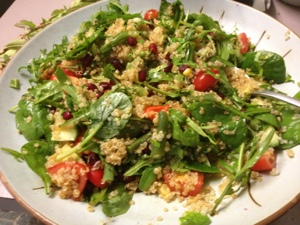Last night, my 4 year old (H) told me two things: 1. He hates tomatoes, which is such a pity as we planted about 15 tomato seedlings last year, mostly cherry and baby Roma, and have picked at least a bowlful each day for the past month or so; and 2. Tomato sauce, one of his favourite things, does not have tomatoes in it, despite the name. So I thought it was time to remind him that he does, actually, like tomatoes, just not fresh ones.
I guess, like lots of other kids, he is a fussy eater, but not always. There are a wide range of things he does eat, but equally there are things he ‘doesn’t’ – the reason for the inverted commas is that he generally does eat them, they are just hidden when he does. I aim to always put at least six vegetables in everything I make (before kids, this was ten types of vegies, but I’ve since reduced the self-pressure) – so when he eats the same foods elsewhere, he thinks they taste funny if there isn’t the same veg quotient… So ‘fussy’ is contextual. It’s also semantic: fussy might be the same as particular, dogmatic, demanding… but sometimes it’s just downright annoying.
A few years back, I came across a recipe that promised to be adored by children. It was in a slow cooking book by Sally Wise; I’ve adapted it a bit (to incorporate my magic 6) and usually do it on the stove. But, after days of fussiness (ie demanding), H ate a huge bowl of the meatballs and the bubaloo had two small serves.
She aims, she kicks, she scores!!!
Unfortunately, I didn’t score on the photos – apologies. They may not look so pretty but they taste good 🙂
Hedgehog meatballs
You will need:
For the meatballs:
1 kg minced beef
1/2 cup uncooked rice
2 small or 1 large eggs, lightly beaten
1 onion, finely chopped
1 stalk of celery, finely chopped
1 carrot, finely chopped
1 small zucchini, finely chopped
1 tbsp mixed herbs
2 tbsp tomato paste + 1/4 cup of condensed tomato soup (just open a 420g tin, I use salt reduced) OR equivalent tomato sauce
2 tbsp barbecue sauce
Salt and pepper
1. Combine all together in a bowl and mix well. Your hands are the best way to do this. Make into balls around 3 cm round.
2. Heat a splash of olive oil in a fry pan. Add 1 crushed clove of garlic (optional). Add the meatballs and brown.
3. Blend together (nb. new ingredients) the rest of the can of soup, 400ml water, and 1.5 cups (ish) tomato passata. Pour over the meatballs.
4. Cover and simmer for 1 1/2 hours or until the rice is cooked. Stir occasionally so the bottom doesn’t burn but do this carefully! The meatballs can fall apart if you are too rough.
5. Serve with steamed vegetables, mashed potatoes, or just plain. This makes enough for a few dinners.
As an aside, my partner told me that his mum used to make this when they were kids. So it’s not a new recipe idea, but it’s clearly a resurgent one 🙂
























